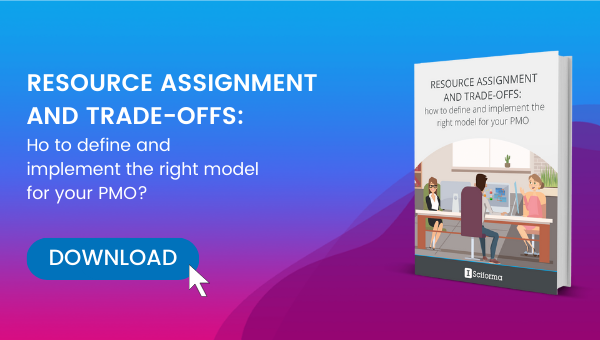For Project Management Offices and portfolio management professionals, managing portfolios of projects at scale and doing it right can require considerable amounts of time and energy. Establishing realistic project schedules, defining the critical path, finding the optimal way to allocate resources across projects and tasks, figuring out the best make-up for a portfolio, and maintaining balance over time are complex and delicate activities. Luckily, there exist many PPM tools on the market. Read on for an overview of the advantages of project portfolio management tools, as well as the key features to look out for to take your PPM to the next level.
PPM Tools at a Glance
Project Portfolio Management systems offer PMOs and project, program or portfolio managers the specific capabilities they need in order to optimize project and portfolio outcomes. Such software tools provide a framework for managing project resources, schedules, and budgets effectively and they help to coordinate all project-related activities so as to maximize value at the level of the portfolio while keeping operational, technical, financial, and organizational risk at bay.
It all starts with the centralization and consolidation of all the data into the platform, which provides a “single version of the truth” for project information and enhances the visibility of the health and status of projects and portfolios. On top of that centralizing layer, PPM software typically offers an array of capabilities designed to simplify and optimize activities, boost productivity, minimize costs, and maximize overall value.
Key Capabilities and Advantages of Project Portfolio Management Software
Task Automation & Productivity Features
PPM tools basically exist to make the lives of project managers and PMOs easier. Accordingly, they come equipped with productivity-oriented capabilities specifically designed to help human project workers save time and energy. For example, a Project Portfolio Management system will automate most of the administrative tasks that usually tie up project managers for extended periods of times without creating much value: formatting data, sending reminders, making calculations, and so forth.
Project Selection & Management of the Pipeline
Managing the inflow of new and upcoming projects is possibly the most critical phase of PPM optimization. The PMO needs to both ensure the volume of resources is equal to the amount of selected and initiated projects, but also ascertain that the firm does pick the right projects. What are the “right” projects? Those that align with the strategic objectives and that will contribute towards achieving the goals and benefits set by executive decision-makers.
A PPM tool’s demand and idea management functionality provides a standard framework to assess the soundness, strategy alignment, and overall quality of the various project propositions. This way, the PPM tool helps portfolio decision-makers pick and plan the best ones. Moving forward, the Phase-Gate review capabilities of portfolio management software provide additional checkpoints to monitor and possibly adjust the course of active projects.
Thanks to the ability to model ‘what-if’ scenarios at the level of the portfolio, the PMO is also enabled to optimize the distribution and grouping of initiatives.
Resource Management
Virtually all PPM tools also offer functionality to help PMOs ensure efficient and effective deployment of the organization’s resources. It is all about making sure that funds, machinery and equipment, and above all skilled workers are where they are most needed at the right time and that the utilization rate of critical resources is optimized. To that end, PPM platforms enable resource managers and portfolio decision-makers to check resource availability and attributes at a glance in order to make the right calls. Arrays of collaborative features designed to facilitate and accelerate the interactions between project managers and resource managers further help to optimize resource allocation and utilization while enabling the implementation and maintenance of a robust and structured process for assigning resources to specific tasks.
Budget & Financial Management
A Project Management Institute research study found that only 59% of projects are completed within budget. The good news is that Project Portfolio Management platforms can really help to improve the performance of project budget allocation and financial management. Because data consolidation in a single platform enhances visibility and understanding of projects, the PMO and financial controllers can improve the accuracy of budget and cost estimates. The ability to track costs in real time and to drill down to filter and categorize them helps the organization to anticipate cost overruns and course-correct in a timely manner. Additionally, PPM systems make it possible to measure project financial value and return against the strategic objectives and priorities of the organization.
Risk Management
Any assessment of the potential return and value of a project should go hand in hand with an analysis of its risk sensitivities. The evaluation of the risk residing within each of the projects can then be used as a basis for determining confidence levels across the portfolio. Project Portfolio Management platforms will usually provide automated techniques for assessing contingency, along with intelligent functionality to help decision-makers come up with the appropriate risk mitigation or risk response plans. In addition to analyzing risk at the outset of project cycle, PPM tools enable portfolio managers to reassess during the course of execution in order to take into account the various changes or issues that might have altered a project’s risk profile.
The capabilities described above are some of the most important features of PPM software. However it is important to keep in mind the fact that not all PMO software tools are equal. Adopting and deploying a Project Portfolio Management system should definitely improve the productivity and efficiency of project work to some degree, but achieving true portfolio optimization really requires picking the tool that is right for your organization.
Browse Sciforma’s Blog Posts About the Advantages of Project Portfolio Management and PPM Tools:
- 3 ways a Project & Portfolio Management Software can increase your team’s productivity by over 30%
- Project Portfolio Management Fundamentals – Using the Right Metrics
- PPM: Walking the Fine Line Between Pessimism and Optimism








Isabelle Bouscatie
With many years as a EMEA Marketing Manager under her belt, Isabelle is presently in charge of Sciforma’s customer marketing and global events. She thrives in Sciforma’s dynamic, fast-paced digital environment and she enjoys working in direct contact with customers, who help her keep abreast of PPM challenges across organizations.